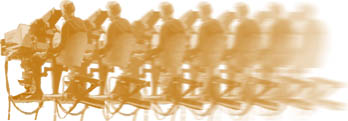In 1950, the BBC had Richard Dimbleby demonstrating a sea rescue off the end of Southend Pier. The nation held its breath as a weighty Dimbleby was seen suspended in a bosun's chair, dangling over a windswept sea. Then, on cue, he was hauled from a yacht to the waiting lifeboat, thus providing instant thrills - would the bosun's chair break-would he fall into the water? -as well as the double bonus of a few hours of extremely cheap television. On the basis that any old excuse would do (from a bank holiday to a coronation), the TV companies would rush instantly, van loads of cameras and miles of cable to any likely festive vantage point. But not too far from London. Nation-wide television was still a few years away and ITV was several companies short of a network.
The actual subject matter seemed not to matter. Everything was new and it was all grist to the TV mill. Indeed, for years, a Southend seafront gypsy fortune-teller had a sign displayed which read proudly: 'As featured on BBC television". Doubtless the clientele were suitably impressed as they crossed palms with silver.
But Southend carnival provided the ultimate black and white TV attraction. In 1956, ATV transmitted the festivities, setting up their cameras and control vans beside the old swimming pool at Westcliff. Included in the day's programme was a beauty contest (typical ITV) from the pool. Later in the afternoon, a proportion of the carnival procession was televised. Two Pye Mk 3 cameras were used, one mounted on a ‘Paddock’ dolly beside the road and the other, on a gantry using a Watson 5:1 zoom lens. What all these Southend programmes actually looked like, I have only fragmentary recollections. Even in those days, our little 9 inch made-in- Southend Ekco television set was working overtime! I seem to recall that these outside broadcasts were fraught with technical and artistic problems. Cameras would focus on the wrong item or break down at critical moments. Commentators would lose their sound-leads or microphones. Interviewees would freeze-up in panic and forget their own names. Strange and inexplicable pauses proliferated. Everything over-ran. And it always seemed to be raining.
No recordings exist of those 1950s Southend outside broadcasts. They were not exactly historic, nor considered at the time worthy of any sort of archive preservation. But, oh to be able to see them now!
My memories of the 1956 Southend carnival are reinforced by the photo-graphs my father and I took of the ATV technical gear. But I shall always recall, fondly, the remark made to me by an ATV cameraman who was photographing the carnival. As a camera-mad 11-year-old, I confessed to him that I wanted to be a TV cameraman when I grew up.
"B-— off, can't you see I’m working?" he muttered helpfully
